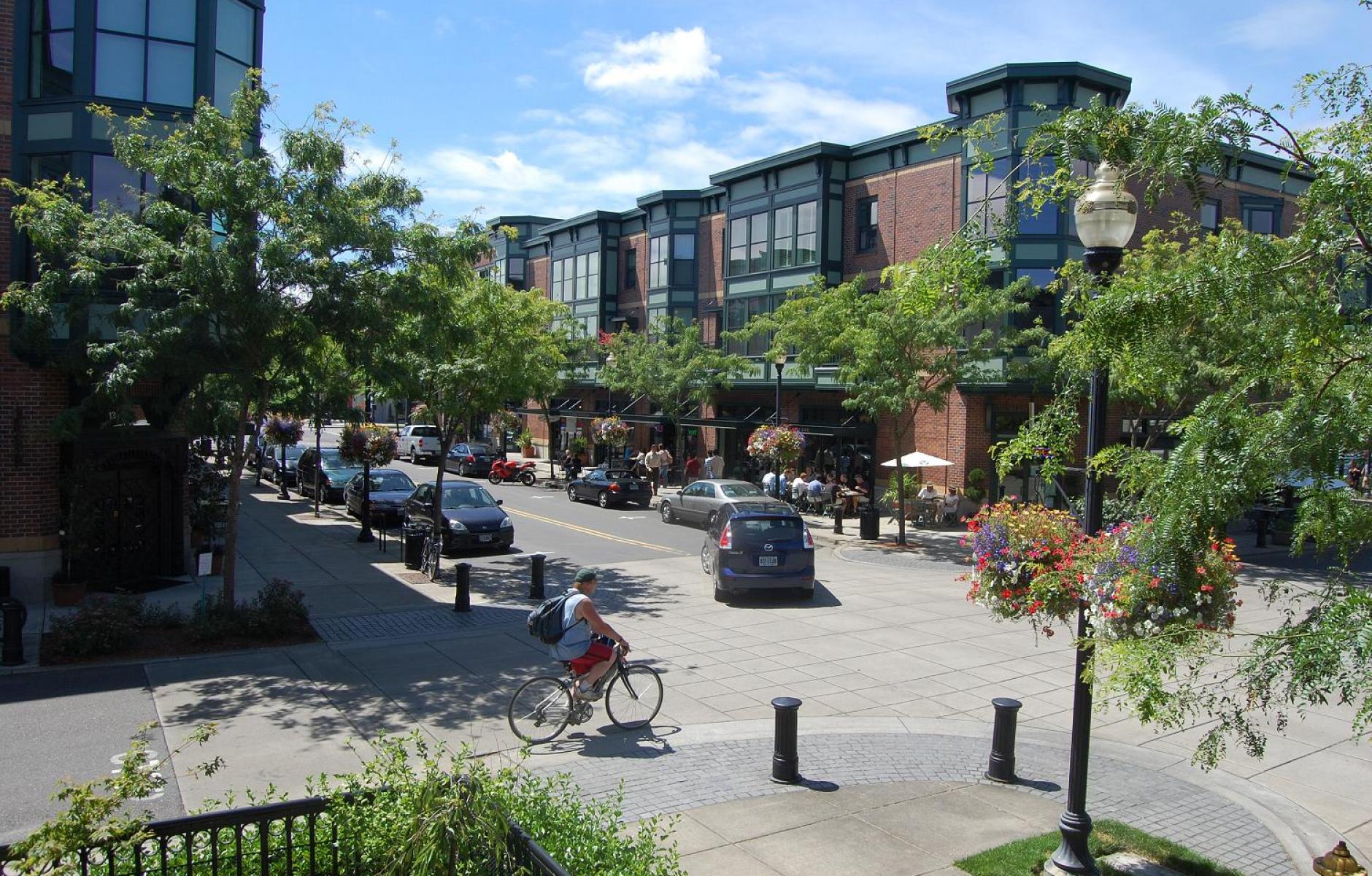
The research is in on New Urbanism—and it’s stronger than you think
In the past, practitioners of the new urbanism – otherwise known as walkable, compact, mixed-use, multi-modal urbanism of the kind that is more common in traditional cities and towns – have been criticized for making ideological pronouncements without a solid foundation of evidence.
We practitioners have presented evidence, to be sure, but it has too often been piecemeal and fragmented. We may have pointed to specific research findings that show that narrower lane widths improve pedestrian safety, perhaps or that walkability affords exercise that is beneficial for health. What has been missing is the big picture – the collective and systemic effects of all these features working together within a neighborhood. We knew from our own observations that there were overwhelmingly strong benefits, but for the most part we haven’t been able to present persuasive evidence.
A just-completed research project at the University of Notre Dame has shown just how compelling that big picture can be. The project has developed a database of over 200 representative research papers from across a wide range of disciplines, with findings on many different impacts of urban form. The goal has been to bring together, for perhaps the first time, research findings from medicine, economics, law, psychology, sociology, ecology, engineering, and other fields, to paint a larger picture of the successes – and the remaining challenges – for the practice of New Urbanism, and related reform movements.
The project has been part of the Housing and Community Regeneration Initiative at the University’s School of Architecture, led by Marianne Cusato, with direction from Dean Stefanos Polyzoides, and contributions from Senior Researchers David Brain and Jim Brainard, both part of the HCRI initiative. Jim Brainard is the long-time mayor of Carmel, Indiana, an award-winning exemplar of a suburban transformation into a national model of livability. David Brain is a long-time member of the Congress for the New Urbanism and a noted sociologist. Dean Stefanos Polyzoides is a co-founder of the Congress for the New Urbanism. This author led the research and database curation process.
Among the more striking findings:
- New urbanist development can save an average of 38 percent on upfront costs for new construction of roads, sewers, water lines and other infrastructure, can generate 10 times more tax revenue per acre than conventional suburban development, and can reduce the costs of ongoing delivery of public services including police, ambulance and fire by an average of 10 percent, according to several peer-reviewed papers.
- New urbanist development can reduce trip generation and parking demand by over half of ITE manual standards, resulting in significant savings to municipalities, businesses and homeowners, and reducing negative impacts on land, water and air quality. (The findings include those from Orenco Station, shown in the photo at top.)
- Homes in New Urbanist neighborhoods can command price premiums of 14.9 percent over comparable properties, reflecting high demand for walkability and mixed-use development. (This finding reminds us of the need for more supply to ease demand and lower prices.)
- Streets in new urbanist neighborhoods are measurably safer than sprawling suburbs due to lower vehicle speeds and pedestrian-friendly street designs, resulting in measurably fewer deaths and injuries, according to several well-documented studies.
- Residents of walkable new urbanist neighborhoods are approximately 50 percent more likely to achieve recommended levels of physical activity compared to those in less walkable areas. Additionally, they are about 24 percent less likely to experience obesity, all other factors being equal.
- A 5 percent increase in walkable infrastructure was found to lead to a 32.1 percent increase in time spent walking, a 6.5 percent reduction in vehicle miles traveled, and a measurable decrease in air pollutants.
- Residents of new urbanist neighborhoods report significantly and measurably higher levels of social trust and civic engagement than those in car-dependent suburbs.
- Older adults living in walkable new urbanist areas experience lower rates of depression, stress-related illnesses, and dementia.
- Traditional walkable and mixed-use development of the kind that is typical in new urbanist neighborhoods can reduce greenhouse gas emissions and air pollutants by 30 percent or more, all other things held equal.
- High-tech firms prefer compact, walkable urban environments, which translates into a boost in regional economic growth.
- Traditional street patterns — such as those found in historic city centers and new urbanist neighborhoods — were found to be associated with lower crime rates, while modern suburban layouts show higher rates of burglary and street robbery, all other factors being equal.
- Most members of the public strongly prefer traditional and vernacular architecture of the kind that is common in new urbanist neighborhoods, and there is evidence that those characteristics are more likely to result in popularity and success in urban development.
The research is drawn from peer-reviewed journals, with a focus on well-cited papers. The papers often cite other previous conclusive research in the field (so-called survey research). Active researchers within the membership of the Congress for the New Urbanism have also contributed review comments to the project. The results will be made available through a web-based database portal, and will also be published in the form of a lengthy report or book. This author is also working on a peer-reviewed paper that will report the summary findings in a well-cited research journal.
Often the results of this kind of "survey research" are as important for the gaps in the research that they identify, as they are for the specific findings they help to disseminate. For this reason, there is important work ahead to conduct or facilitate additional research to help to fill in those gaps.
One particularly important area is project-based research, evaluating the specific achievements of new urbanist projects in comparison to their goals. For example, Orenco Station’s research results demonstrate its achievements in trip generation reduction, parking demand reduction, and positive indicators of social cohesion and trust. This kind of evidence is what is needed to convince policymakers and stakeholders of the potential achievements of new urbanist practice – but much more is needed.
This project has also documented many economic benefits of new urbanist development. (Reductions in parking demand and trip generation are examples, since they reduce costs of land, construction, and maintenance.) At the same time, the project also documented many of the remaining barriers to new urbanist development. These obstacles make New Urbanism much harder to implement, and they constitute hidden subsidies for “business as usual.” This too is a critical area of much-needed follow-up research, providing much-needed implementation streamlining for policy and practice.
One of the more surprising barriers may be our own misunderstanding as practitioners of the usefulness of urban research. There are common misconceptions about the role of research in relation to practice. One is the belief that a given finding must be conclusive – must be “proof” – or else the effort to engage the research is futile.
But in the world of research, rarely does one finding conclusively “prove” a fact. In most fields of research, the goal is not “proof” but the “preponderance of evidence” – that is, we develop and confirm our theories as guides to our practice, unless and until they are disproven. Until then, our goal is to show that our theory is better than the others out there – it is more likely to “deliver the goods,” in whatever field.
Like any practitioner, new urbanist practitioners certainly have their own theories about the patterns and practices that will result in better outcomes for human beings, as judged by them, and by us all. We have the same obligation to demonstrate the validity of our theories as any professional, if we are to be credible, and to drive successful reform with persuasive evidence to rebut our critics.
Perhaps our role as practitioners can be compared to that of medical practitioners. While we usually don’t conduct the research ourselves, it’s important to be aware of it, and to be able to communicate its findings to our “patients” – the governments, businesses, and citizens that we serve. Too often, however, the research doesn’t find its way into practice and policy, leading to a lack of progress on critical urban issues. It’s as though a series of new life-saving medicines were discovered, only to be ignored by practitioners.
The great urban journalist Jane Jacobs may have put it best when she accused her generation of planners of practicing “pseudo-science” – seemingly almost neurotic in their “determination to imitate empiric failure and ignore empiric success.”
We have the empirical success to accumulate, to show, and to learn from – and it’s urgent that we do so.
Note: The database of research papers and findings, the long-form report, and academic paper are expected to be released later this year.




